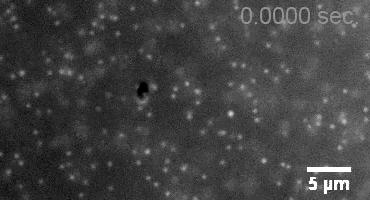Control of Magnetic Nanoparticles for Nanoscale Manipulation of Fluids and Materials (Archived)
Summary
Scientists and engineers currently have a growing library of synthetic microscale and nanoscale swimmers which affect the hydrodynamics of their surroundings in ways analogous to microorganisms. In nature, the life processes of microscopic organisms such as bacteria rely on actively disturbing their fluid surroundings as they swim and researchers have used particle tracking experiments to elucidate the hydrodynamics involved in their motion. Magnetic nanostructures in solution can be turned into synthetic swimmers by controlling their rotation and translation using magnetic fields. The goal of this project is to develop techniques to precisely track synthetic swimmers and quantify their hydrodynamic impact on their surroundings and determine the scale and nature of their sphere of influence.
Description
Low Reynolds number swimming, or motion through a viscous fluid, is a technique at which nature is adept. Bacteria, protists, and algal cells live in a regime where viscous effects dominate inertial ones. As these microscale biological swimmers move, they perturb the fluid around them, affecting fluid behavior within a particular hydrodynamic interaction volume. The fluid motion within these regions, and the interactions between them, can be observed and understood using passive tracer particles.
Mimicking microorganisms, synthetic microscale and nanoscale swimmers are now capable of performing tasks such as cargo pickup and drop-off, single cell manipulation, and tissue penetration. We are interested in understanding how these synthetic swimmers move the fluid surrounding them, especially in non-Newtonian fluids such as the extra-cellular matrix and biofilms, and how far away from the swimmers their hydrodynamic effects persist.
In one project we seek to measure these spheres of influence around rotationally actuated magnetic nanorod swimmers. We are developing camera-based tracking methods to observe the motion of multiple passive nanoscale tracer particles at millisecond time resolution and in three dimensions. This will enable us to measure the hydrodynamic effects when the interaction volumes of two swimmers approach and interact with one another.
Using hundreds of summed microscopic images of 500 nm-diameter fluorescent particles, we are able to observe the sphere of influence around a rotationally actuated magnetic swimmer. From these observations, we can distinguish regions of high, medium and low entrainment – regions in which one area of fluid is moved by another. In the high entrainment region, particles experience strong advective currents; in the moderate entrainment region, particles experience advective transport with a strong diffusive component; and in the low entrainment region, particles are essentially only diffusing.



